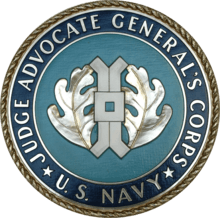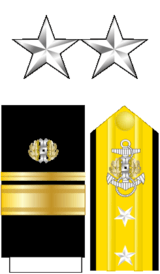Judge Advocate General's Corps, U.S. Navy
| Judge Advocate General's Corps | |
|---|---|
 | |
| Active | 1967 – present |
| Country |
|
| Branch |
|
| Type | Military Justice (Navy) |
| Role | Legal and policy advice to the Secretary of the Navy |
| Part of | Department of the Navy |
| Garrison/HQ | Washington Navy Yard, Washington, D.C, U.S. |
| Commanders | |
| Current commander | Vice Admiral James W. Crawford, III Judge Advocate General of the Navy |
| Insignia | |
| Identification symbol |
 |
The Judge Advocate General's Corps also known as the "JAG Corps" or "JAG" is the legal arm of the United States Navy. Today, the corps consists of a worldwide organization of more than 730 Judge Advocates, 30 limited duty officers (law), 500 enlisted members and nearly 275 civilian personnel, serving under the direction of the Judge Advocate General of the Navy.
The headquarters of the Judge Advocate General's Corps of the United States Department of the Navy is located at the Washington Navy Yard in Washington, D.C.
History
In 1775, the Continental Congress enacted the Articles of Conduct, governing the ships and men of the Continental Navy. However, soon thereafter, all of these ships were sold and the United States Navy and Marine Corps were disbanded. In July 1797, Congress, after authorizing construction of six ships, enacted the Rules for Regulation of the Navy as a temporary measure. Then, in 1800, Congress enacted a more sophisticated code adopted directly from the British Naval Code of 1749. There was little or no need for lawyers to interpret these simple codes, nor was there a need for lawyers in the uncomplicated administration of the Navy prior to the American Civil War.
During the Civil War, however, Secretary of the Navy Gideon Welles named a young assistant U.S. Attorney in the District of Columbia named Nathaniel Wilson to present the government's case in complicated courts-martial. Without any statutory authority, Secretary Welles gave Wilson the title of "Solicitor of the Navy Department," making him the first House counsel to the United States Navy.
By the Act of March 2, 1865, Congress authorized "the President to appoint, by and with the advice and consent of the Senate, for service during the rebellion and one year thereafter, an officer of the Navy Department to be called the 'Solicitor and Naval Judge Advocate General.'" The United States Congress maintained the billet on a year-to-year basis by amendments to the Naval Appropriations Acts. In 1870, Congress transferred the billet to a newly established Justice Department with the title of Naval Solicitor.
In 1967, Congress decided to establish the Judge Advocate General's Corps within the Department of the Navy. The legislation was signed into law by President Lyndon B. Johnson on December 8, 1967, and redesignated Navy lawyers as staff officers within the Navy, similar to physicians and chaplains. Prior to this change, all Navy lawyers were Line Naval Officers.
Prior to 2005, JAG Corps personnel primarily worked in one of three offices: Navy Legal Service Offices providing defense and legal assistance to eligible personnel; Trial Service Offices providing courts-martial prosecution, court reporting and administrative trial support; and Staff Judge Advocates providing legal advice to U.S. naval base commanders. In 2005, the Judge Advocate General of the Navy approved a pilot program which resulted in the merger of the Navy's Trial Service Offices and Staff Judge Advocates into new commands known as Region Legal Service Offices. Additionally, the JAG Corps has attorneys and paralegals on aircraft carriers, amphibious assault ships and flag ships as well as in support of Seabee battalions and special operations commands.
The insignia

The official insignia of the JAG Corps consists of two gold oak leaves, curving to form a semicircle in the center of which is balanced a silver "mill rinde" [sic], In ancient France, the fer de moline, or millrind, was a symbol of equal justice for all under the law. The two counterbalancing oak leaves are identical and connote the scales upon which justice is weighed. Oak leaves denote a corps, and symbolize strength, particularly the strength of the hulls of the early American Navy, which were oak-timbered. In the milling of grains, the millrind was used to keep the stone grinding wheels an equal distance apart to provide consistency in the milling process. It, thus, symbolizes that the wheels of justice must grind exceedingly fine and exceptionally even. In the 16th century, this symbol was adopted in England as a symbol for lawyers.
The millrind can also be found in both the Staff Corps Officers Specialty Insignia and in the Enlisted Rating Insignia (LN Legalman).
U.S. Navy ranks and insignias for JAG officers
| Judge Advocate General's Corps, U.S. Navy | ||||||||||
|---|---|---|---|---|---|---|---|---|---|---|
| Vice Admiral Judge Advocate General of the Navy |
Rear Admiral Deputy Judge Advocate General of the Navy |
Rear Admiral (lower half) | ||||||||
| O-9 | O-8 | O-7 | ||||||||
 |
 |
_O7.png) | ||||||||
| Captain |
Commander |
Lieutenant Commander |
Lieutenant |
Lieutenant (junior grade) |
Ensign |
|---|---|---|---|---|---|
| O-6 | O-5 | O-4 | O-3 | O-2 | O-1 |
 |
 |
 |
 |
_O2.png) |
 |
Legalman
- See: List of United States Navy ratings#Administration, deck, technical, and weapons specialty ratings (at "Legalman")
Legalmen are trained paralegals who assist Navy and Marine lawyers and work in Navy legal offices.
Naval Justice School
Judge Advocate General of the Navy
The Judge Advocate General of the Navy (JAG) and the Deputy Judge Advocate General of the Navy (DJAG) are appointed positions. They are both nominated by the President and must be confirmed via majority vote by the Senate. The JAG and DJAG are appointed to a four-year term of office but they usually serve for three. The JAG and DJAG have historically been officers in the service of the Navy. However statute states that a Marine officer [1] can be appointed to either position as long as he meets the requirements stated in the section. By statute the JAG is appointed as a three-star vice admiral or lieutenant general while holding office [2][3] and the DJAG is appointed as a two-star rear admiral or a major general.[2][3][4] Other than age and years of military service, there is no other statute of limitations on how many times a JAG or DJAG can be renominated for appointment to that position if the President so chooses.
List of Judge Advocates General of the Navy
Offices
Headquarters
- Judge Advocate General Corps HQ, Washington Navy Yard, Washington, D.C.
Defense Service Offices (DSO)
North
- DSO North Headquarters, Washington Navy Yard, Washington, D.C.
- DSO North Detachment, Naval Support Activity Naples, Italy
- DSO North Branch Office, Naval Support Activity Bahrain, Bahrain
- DSO North Detachment, Naval Station Rota, Spain
- DSO North Branch Office, U.S. Naval Academy, Maryland
- DSO North Detachment Groton, Naval Submarine Base New London, Connecticut
- DSO North Detachment Great Lakes, Naval Station Great Lakes, Illinois
West
- DSO West Headquarters, Naval Station San Diego, California
- DSO West Bremerton, Naval Station Bremerton, Washington
- DSO Central Branch Office Fort Worth, Naval Air Station Joint Reserve Base Fort Worth, Texas
Pacific
- DSO Pacific Headquarters Yokosuka, United States Fleet Activities Yokosuka, Japan
- DSO Pacific Sasebo, United States Fleet Activities Sasebo, Japan
- DSO Pacific Guam, Naval Base Guam, Guam
- DSO Pacific Pearl Harbor, Pearl Harbor Naval Shipyard, Hawaii
Southeast
- DSO Southeast Headquarters, Naval Station Norfolk, Virginia
- DSO Southeast Detachment Mayport, Naval Station Mayport, Florida
- DSO Southeast Detachment Pensacola, Naval Air Station Pensacola, Florida
- DSO Southeast Branch Office Jacksonville, Naval Air Station Jacksonville, Florida
- DSO Southeast Branch Office Gulfport, Naval Construction Battalion Center Gulfport, Mississippi
- DSO Southeast Remote Office New Orleans, Naval Air Station Joint Reserve Base New Orleans, Louisiana
- DSO Southeast Remote Office Millington, Naval Support Activity Mid-South, Tennessee
- DSO Southeast Remote Office Kings Bay, Naval Submarine Base Kings Bay, Georgia
- DSO Southeast Remote Office Guantanamo Bay, Guantanamo Bay Naval Base, Cuba
Region Legal Service Offices (RLSO)
Capital Region
- RLSO Naval District Washington, Washington Navy Yard, Washington, D.C.
- RLSO Northeast Detachment Great Lakes, Naval Station Great Lakes, Illinois
Southeast
- RLSO Southeast Jacksonville, Naval Air Station Jacksonville, Florida
- RLSO Southeast Detachment Mayport, Naval Station Mayport, Florida
- RLSO Southeast Detachment Pensacola, Naval Air Station Pensacola, Florida
- RLSO Southeast Detachment Guantanamo Bay, Guantanamo Bay Naval Base, Cuba
- RLSO Southeast Detachment New Orleans, Naval Air Station Joint Reserve Base New Orleans, Louisiana
Mid-Atlantic
- RLSO Mid-Atlantic, Naval Station Norfolk, Virginia
- RLSO Mid-Atlantic Branch Office Oceana, Naval Air Station Oceana, Virginia
- RLSO Mid-Atlantic Branch Office Little Creek, Joint Expeditionary Base Little Creek Fort Story, Virginia
- RLSO Mid-Atlantic Detachment Groton, Naval Submarine Base New London, Connecticut
Southwest
- RLSO Southwest, Naval Station San Diego, California
- RLSO Southwest Branch Office Ventura County Naval Surface Warfare Center Port Hueneme, California
- RLSO Southwest Branch Office Lemoore Naval Air Station Lemoore, California
Northwest
- RLSO Northwest, Naval Station Bremerton, Washington
- RLSO Northwest, Branch Office Naval Station Everett, Washington
- RLSO Northwest, Branch Office Naval Station Bangor, Washington
- RLSO Northwest, Branch Office Naval Air Station Whidbey Island, Washington
Pacific
- RLSO Pacific Pearl Harbor Naval Shipyard, Hawaii
- RLSO Pacific Detachment Yokosuka United States Fleet Activities Yokosuka, Japan
Europe Africa and Southwest Asia
- RLSO Europe Africa and Southwest Asia Naval Support Activity Naples, Italy
- RLSO Europe Africa and Southwest Asia Detachment Rota, Spain Naval Station Rota Spain
- RLSO Europe Africa and Southwest Asia Detachment Sigonella, Sicily Naval Air Station Sigonella, Italy
- RLSO Europe Africa and Southwest Asia Detachment Bahrain Naval Support Activity Bahrain, Bahrain
Trial Judiciary Offices
- Northern Circuit, Washington, D.C.
- Central Circuit, Norfolk, Virginia
- Eastern Circuit, Camp Lejeune, North Carolina
- Southern Circuit, Pensacola, Jacksonville, Mayport, Florida
- Western Circuit, San Diego, California; Bremerton, Washington; Camp Pendleton, California
- WESTPAC Circuit, Pearl Harbor, Hawaii; Okinawa, Japan; Yokosuka, Japan
See also
- U.S. Marine Corps Judge Advocate Division
- Navy-Marine Corps Court of Criminal Appeals
- U.S. Army Judge Advocate General's Corps
- U.S. Air Force Judge Advocate General's Corps
- U.S. Coast Guard Legal Division
- Judge Advocate General's Corps
- Judge Advocate General
- Military law
- Equivalents in other countries
- Portrayal in media
Notes
- ↑ 10 USC 5148. Judge Advocate General’s Corps: Office of the Judge Advocate General; Judge Advocate General; appointment, term, emoluments, duties.
- 1 2 Pub.L. 110-181: National Defense Authorization Act for Fiscal Year 2008
- 1 2 Pub.L. 110-181: National Defense Authorization Act for Fiscal Year 2008 full text
- ↑ 10 USC 5149. Office of the Judge Advocate General: Deputy Judge Advocate General; Assistant Judge Advocates General.
External links
- U.S. Navy Judge Advocate General's Corps official website
